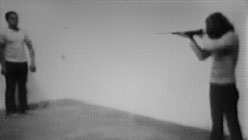Welcome to Help Desk, where I answer your queries about making, exhibiting, finding, marketing, buying, selling — or any other activity related to — contemporary art. Together, we’ll sort through some of art’s thornier issues. Email helpdesk@dailyserving.com with your questions. All submissions remain strictly anonymous and become the property of Daily Serving.
How important is it to consider the intent of an artist when viewing his or her work?
Your position on this matter depends on how you feel about the artist’s desire for a particular expression versus your own powers of interpretation. On one hand, we might wish to honor — or at least consider — the stated intentions of the artist when viewing the work, even if only to see how it matches up against our own perception. On the other hand, “works of the imagination are sites of interpretation,” claims artist David Robbins in his book Concrete Comedy. “Indeed they are made in order to be interpreted; art is not simply a matter of ‘appreciation,’ of ‘understanding the artist’s intentions.’ If we accept that the spectator completes the work, then it follows that the audience for imaginative works may interpret them with the same freedom and intensity that informed their creation. Nothing can and should prevent us from offering imaginative interpretations of works of the imagination, since every individual’s relation to their own imagination is sacred — more sacred, even, then is respecting an artist’s intentions. The idea that certain interpretations must be cordoned off and others reinforced without challenge… is a position finally impossible to defend. To do so is to violate an essential principle of human history.”
Sometimes I think a former professor had the last word on pointing out the limits of artistic intent when he asked, “Given how very little most people really know about themselves, why should we trust their stated intentions?”

Chris Burden, Shoot, 1971.
Do you think that tattooing/tattoo derived imagery (drawings, flash, etc) is a valid form of contemporary art? Would you view it as a fine art, an occupation, or a mixture of both? Do you think a hierarchy of importance should be in place when talking about contemporary art and its applications?





